Don’t let a small space hold you back from having a mudroom that actually works for your family. Even the tiniest entryway can become an organized spot that catches dirt and clutter before it spreads through your home.
Remember to repin your favorite images!
You can totally create a functional mudroom in almost any small space with smart design and a little creativity.
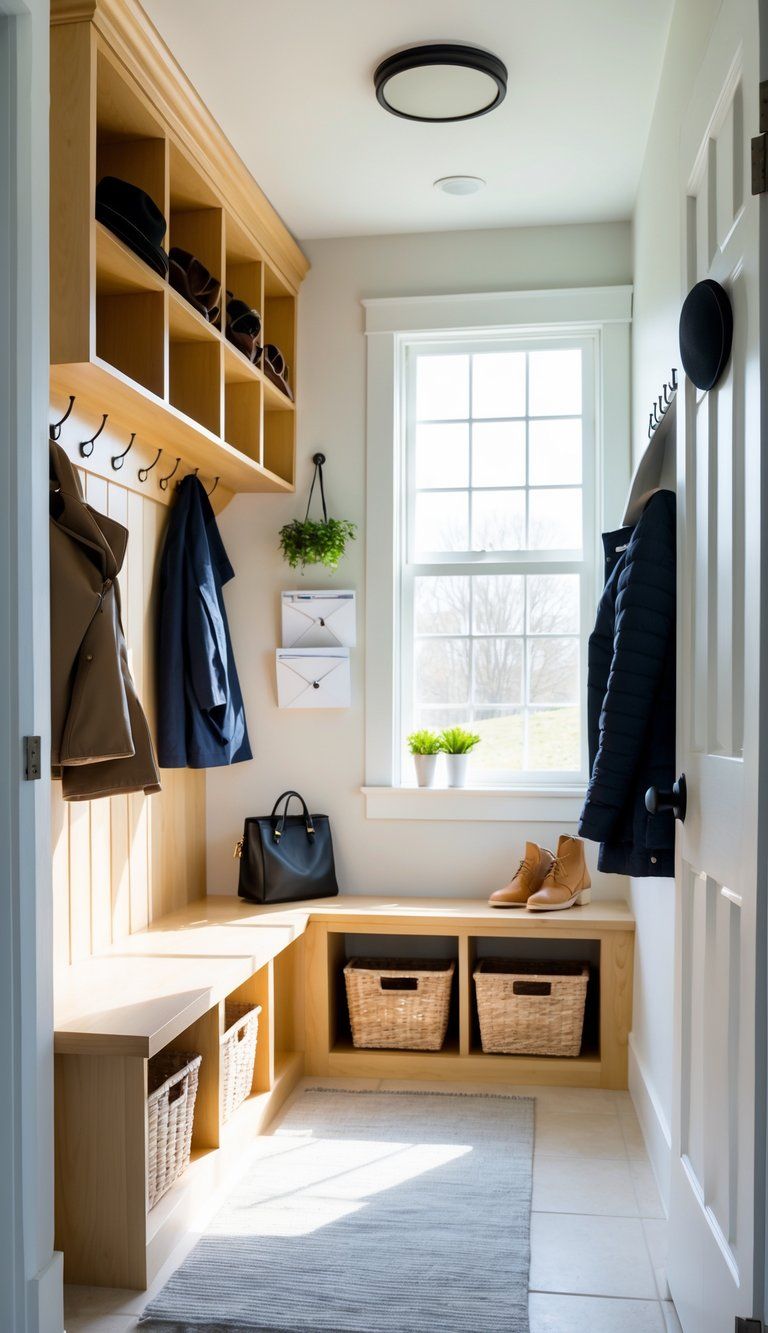
You’ll want to make every inch count in a small mudroom. Try vertical storage like wall-mounted hooks, floating shelves, or stacked cubbies to use space that otherwise just sits empty.
Benches with hidden storage underneath do double duty. You get a spot to sit and a place to stash shoes or seasonal stuff.
Add in some personal touches so the mudroom feels like part of your home, not just a dumping ground. Maybe a bright paint color, a little plant, or some cute baskets—inject a bit of style and keep things functional.
Even the tiniest transition area can work for you if you set up an organization system that fits your family’s needs. Don’t underestimate what a little planning can do.
Essential Elements of a Functional Mudroom
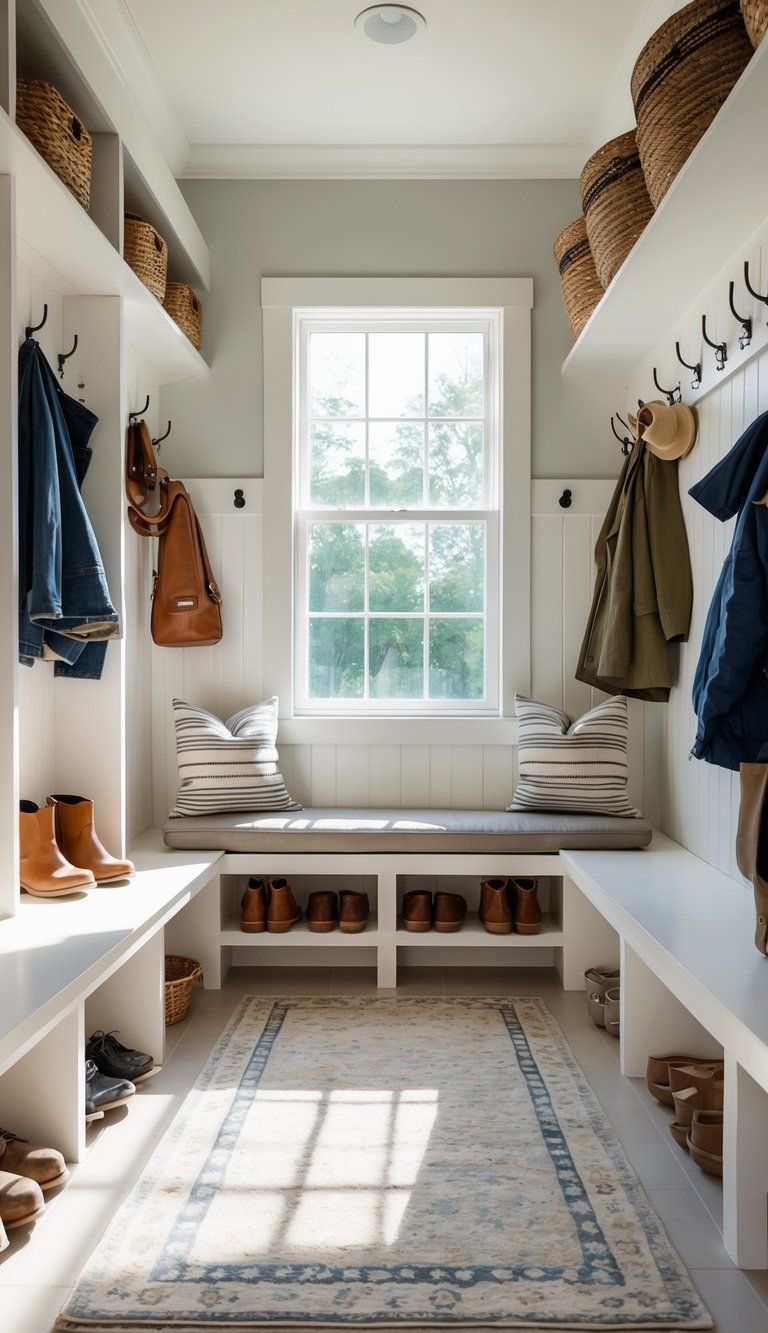
A good mudroom acts as a buffer, keeping the rest of your home cleaner and less chaotic. Let’s look at some elements that really make a functional mudroom work, even when space is tight.
Entryway Considerations
The entryway sets the mood for your mudroom. Start by looking at your family’s habits and how people move through the space.
Do you need enough room for more than one person at a time? Got pets that need their own spot?
Flooring matters a lot. Go for durable, water-resistant options like tile, luxury vinyl, or slate. These hold up against mud, snow, and water, and they’re easy to clean.
Don’t forget lighting—it’s more important than people think. Put in bright overhead lights so you’re not fumbling around in the dark. Motion-activated lights are a lifesaver if your hands are full.
Consider your local weather. If you deal with snow and rain, set aside space for wet boots and umbrellas so you don’t end up with puddles everywhere.
Key Features for Small Spaces
When you’re working with limited space, you’ve got to get creative. Wall-mounted hooks and shelves make use of vertical real estate.
Install hooks at different heights so both adults and kids can reach them.
Space-Saving Solutions:
- Narrow benches with storage underneath
- Wall-mounted cabinets instead of bulky floor units
- Stackable bins for off-season gear
- Fold-down drying racks that tuck away when not needed
Pick multi-functional furniture whenever you can. Benches that double as shoe storage or even charging stations make a big difference.
Custom built-ins maximize weird corners or spots under the stairs. They cost more, but you get a perfect fit for your needs.
Optimizing Organization
Give each family member a designated zone to cut down on clutter. Labeled hooks or cubbies help everyone know where their stuff goes.
Mix open and closed storage. Keep daily essentials easy to grab, and stash the rest in closed cabinets to avoid that messy look.
Smart Organization Systems:
- Shoe racks or cubbies near the door
- Drawer dividers for small stuff like gloves and scarves
- Baskets for sports gear
- Hidden charging stations for phones and tablets
Go vertical with wall organizers for mail, keys, and other little things that always seem to pile up. A small bulletin board or whiteboard helps with reminders or quick notes.
Stick a waste basket in there for emptying pockets, and maybe a small mirror for last-minute checks. Little things like that make the space more useful without eating up room.
Clever Storage Solutions for Compact Mudrooms
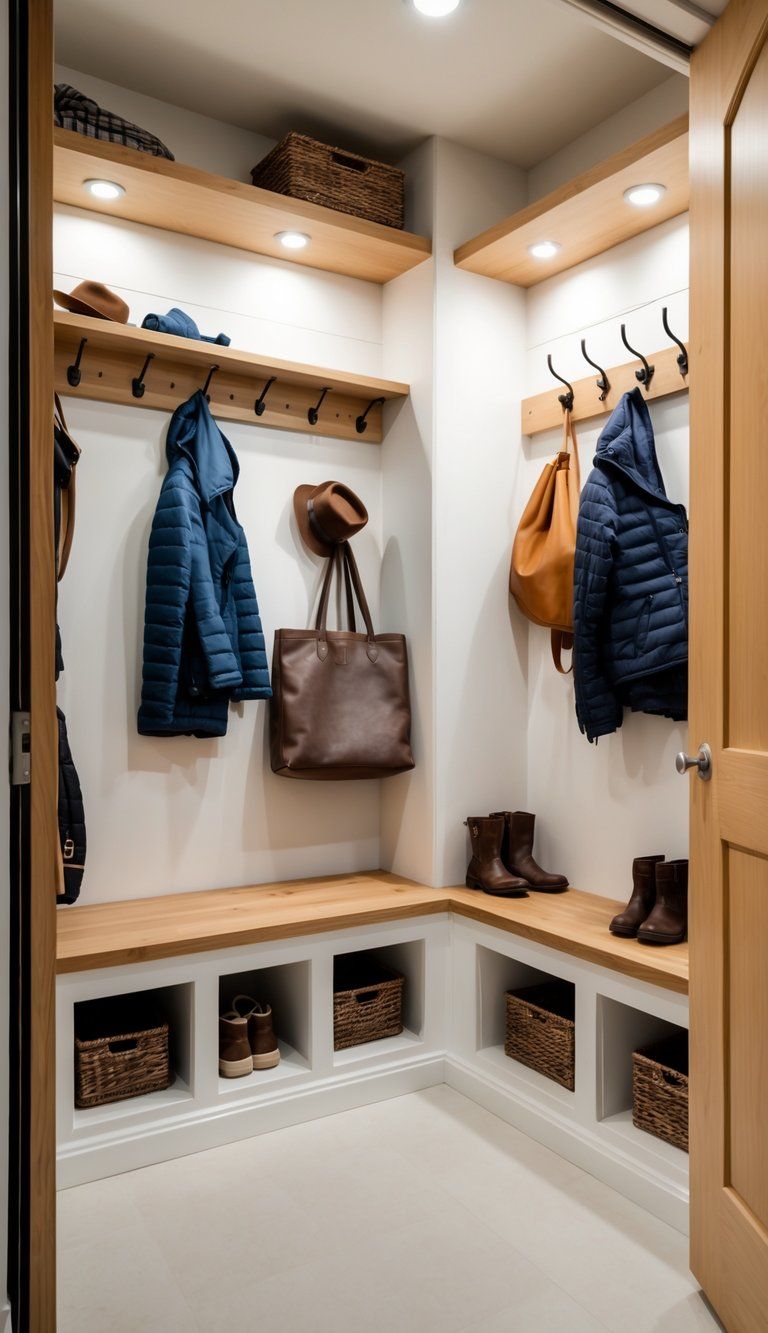
You can turn even the smallest entryway into a functional mudroom with the right storage tricks. Smart organization lets you squeeze the most out of every inch.
Built-In Storage and Custom Built-Ins
Built-in cabinets use every bit of available space. Custom built-ins fit awkward corners or weird wall shapes—standard furniture just can’t do that.
Try floor-to-ceiling cabinets to make the most of vertical space. You can give everything—shoes, coats, bags, sports gear—a dedicated spot.
Bench seating with storage underneath is a classic for a reason. You get a seat and hidden storage for all the stuff you don’t want out in the open.
Custom cubbies that fit your family’s stuff mean no wasted space. Mix open and closed storage so you can hide clutter but still grab the things you use all the time.
Wall-Mounted Hooks and Racks
Wall-mounted hooks and racks keep the floor clear. Install hooks at different heights so everyone can reach, from adults to little kids.
Heavy-duty hooks hold coats, bags, and even dog leashes. Pick ones that look good and work hard.
Wall-mounted shoe racks keep shoes off the floor and organized. Try them on the back of a door or a blank wall.
Multi-tiered wall organizers are awesome for mail, keys, and tiny accessories. They keep daily stuff in sight but not all over the place.
Stick a magnetic strip at eye level for keys and metal odds and ends. No more frantic searches as you head out the door.
Vertical Storage Strategies
When you’re out of floor space, go up! Tall, narrow shelves use wall space from floor to ceiling.
Stackable bins or baskets on those shelves help sort stuff by person or category. Label each bin so you’re not guessing what’s inside.
Over-the-door organizers add instant storage—great for shoes, cleaning supplies, or winter hats and gloves.
Pegboard walls give you flexible storage. Move hooks and baskets around as your needs change.
Ceiling-mounted racks are handy for things you barely use, like holiday decorations or camping gear. Just make sure you install them safely.
Hidden and Closed Storage
Closed storage hides the mess in small mudrooms. Simple cabinet doors make the whole space feel neater and more open.
Pull-out drawers use deep spaces without making things hard to reach. They’re great for hats, gloves, and other small stuff.
Furniture with hidden compartments—think storage ottomans or benches—lets you stash things out of sight without making the room look crowded.
Slim cabinets with mirrored doors do double duty. You get a place to check your hair and a spot to hide extra gear.
Sliding doors on tracks need less space than regular doors, which is perfect when every inch counts.
Maximizing Organization With Multipurpose Furniture
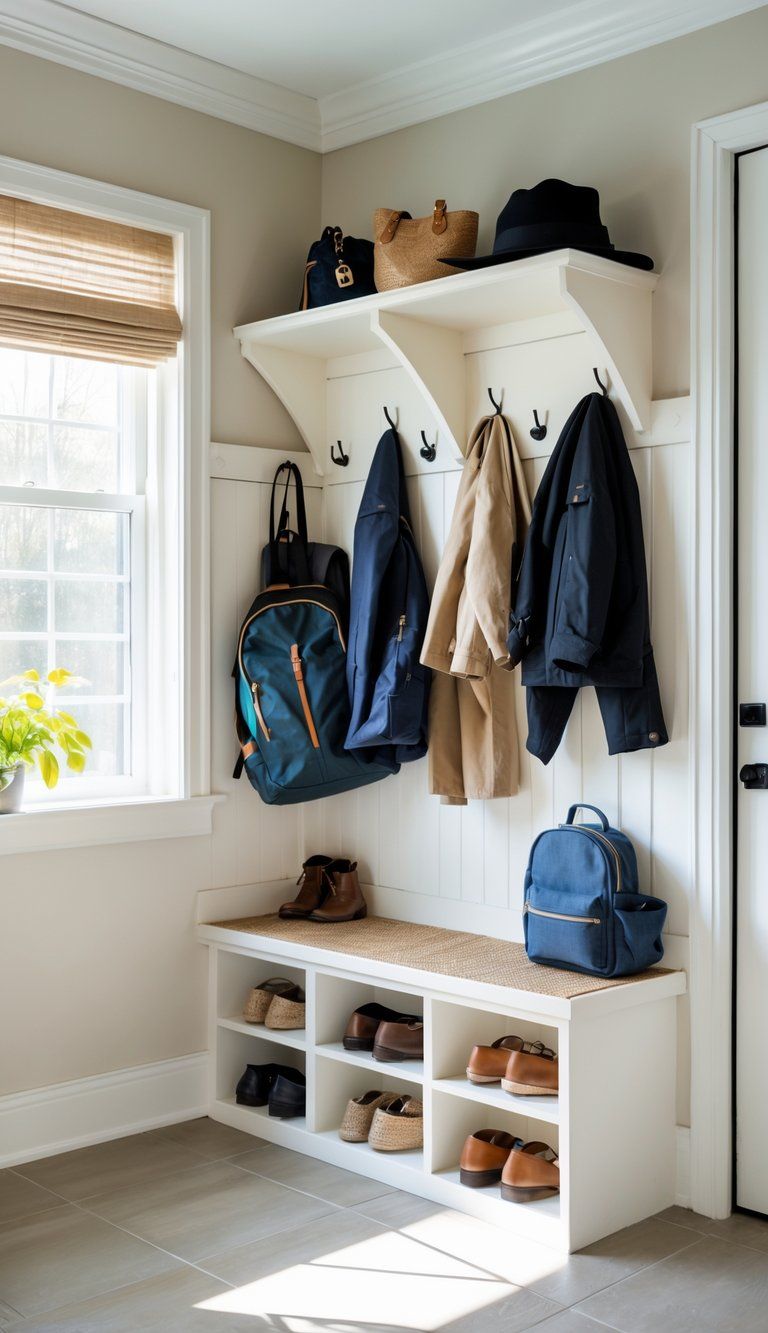
Furniture that does more than one job is a lifesaver in a tiny mudroom. These clever pieces help you stash more stuff without hogging space.
Bench With Storage Options
A storage bench is pretty much a mudroom must-have. You get a comfy spot to sit and room underneath for shoes or bags.
Look for benches with cubbies, drawers, or a lift-up seat. They come in all sizes, from small 30-inch ones to longer 60-inch benches.
For bigger families, pick a bench with divided storage so everyone has their own spot. Some benches even have built-in shoe racks—super handy.
A cushioned top adds comfort, and if you can, get one that’s waterproof or washable. Mudroom benches see a lot of action.
Modular and Foldable Furniture
Modular furniture adapts as your needs change. Stackable cubes fit into corners and can be arranged vertically or horizontally.
Pick cubes with different features—some open, some with drawers. That way, you get storage that actually fits your stuff.
Foldable furniture is a game changer for tight spaces. Wall-mounted drop-leaf tables fold flat when you’re done sorting mail or groceries.
Collapsible coat racks and drying racks expand when you need them and shrink down when you don’t. They’re easy to stash out of the way.
Hall Trees and Lockers
Hall trees combine hooks, a bench, and shelves or cubbies in one piece. They’re a great all-in-one solution for small entryways.
Narrow hall trees fit into tight spots, sometimes needing only a foot of depth. Some even have mirrors to make the area feel bigger.
Locker-style storage gives each family member their own space. Everyone gets a spot for coats, bags, and shoes.
Metal or wood lockers with mesh doors let wet stuff dry out. Compact versions offer just a small cabinet with hooks, which works for really tight spaces.
Wall-mounted lockers don’t take up any floor space. Install them at different heights to work for both kids and adults.
Smart Solutions for Shoe and Outerwear Storage
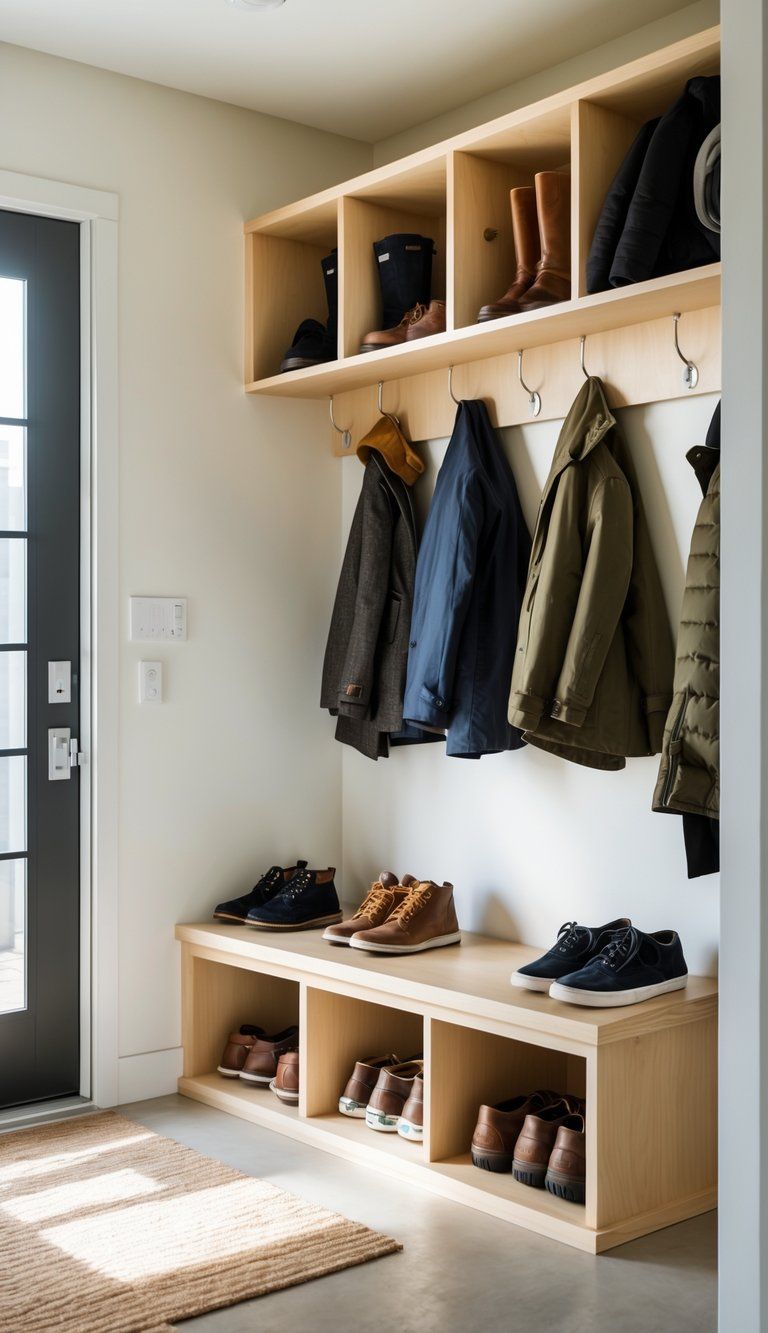
A tidy entryway makes daily life so much smoother. The right storage can turn even the tiniest mudroom into a space that handles shoes, coats, and all those random accessories.
Shoe Racks and Shoe Storage
Vertical shoe storage is a space-saver. Wall-mounted racks keep shoes off the floor and easy to grab.
You’ll find all sorts of styles, from basic shelves to decorative ones that actually look good in your home.
If your family has a lot of shoes, try an over-the-door organizer. It uses space you’d otherwise ignore.
A bench with shoe compartments underneath gives you a seat and a spot to tuck away footwear.
Space-saving tip: Rotate shoes by season. Store winter boots in bins during summer and swap them out when the weather changes.
Coat Racks and Hanging Options
Wall-mounted hooks are perfect for tiny entryways. Install them at different heights so everyone can reach.
Pick sturdy hooks that hold heavy coats without tearing out of the wall.
Hook placement guide:
- Adult height: 60-66 inches from floor
- Child height: 36-48 inches from floor
- Spacing between hooks: 8-12 inches
Freestanding coat racks work in corners. Some even have umbrella holders at the base for extra function.
A wall-mounted grid system lets you add or move hooks as needed. It’s flexible for changing seasons or storage needs.
Baskets, Bins, and Storage Cubbies
Labeled bins help everyone stay organized. Use waterproof bins for wet stuff and breathable baskets for gloves, scarves, and hats.
Labels make it clear where things go, so nobody has to guess.
Cubbies give each family member their own spot. Assign a cubby for daily essentials to cut down on morning chaos.
Under-bench baskets slide out of sight. They’re great for seasonal items or sports gear you don’t need every day.
Organization tip: Try color-coding bins by family member. It’s easier than reading labels and keeps everyone’s stuff separate.
Design Tips for Aesthetic and Practical Small Mudrooms
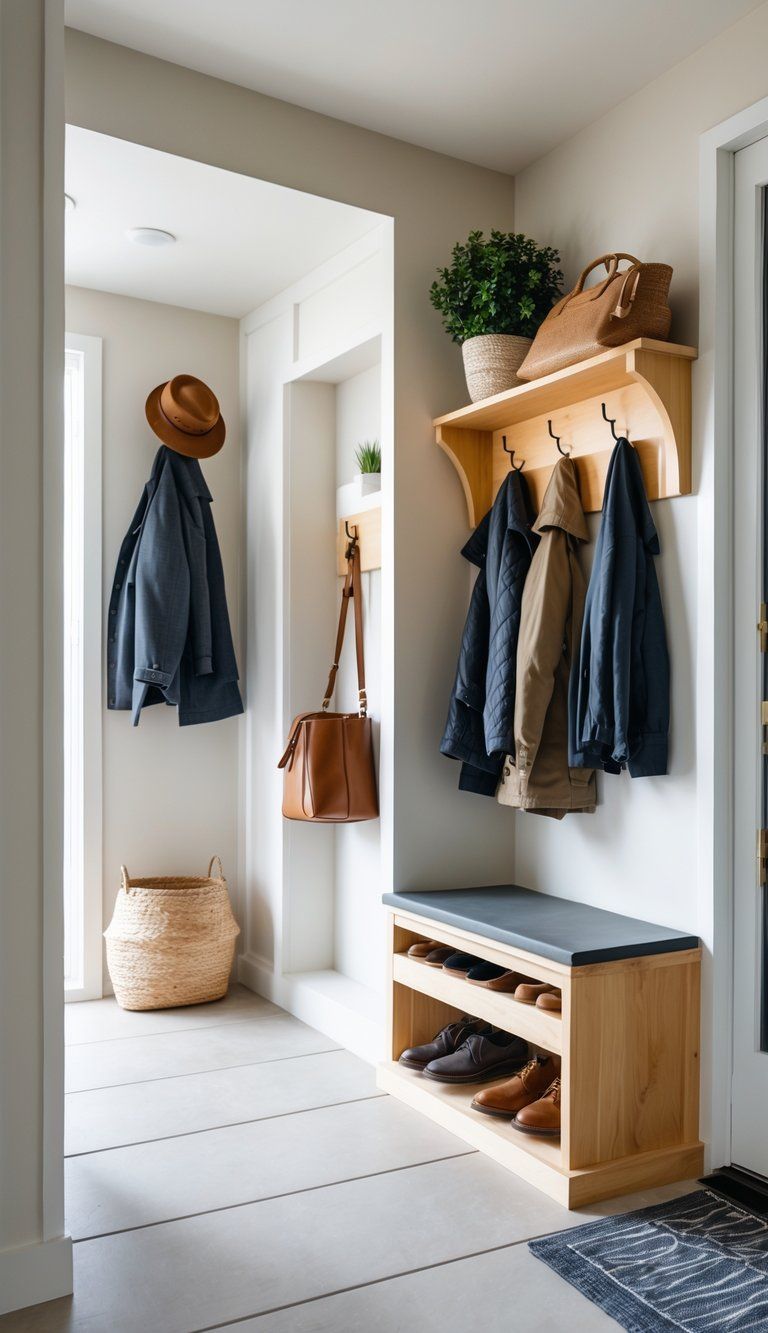
You don’t need a big room to end up with a beautiful mudroom. With a few smart design choices, you can pull together a space that actually works for your daily routine—and still looks good.
Light Colors and Open Shelving
Light colors help small mudrooms feel bigger and more open. White, cream, or soft gray walls bounce light around and make tight spaces feel less cramped.
Wall Color Tips:
- Go for satin or semi-gloss paint—it wipes clean easily.
- Try light blue or sage green if you want a hint of color.
- Stick some removable wallpaper on one wall for a quick accent.
Open shelving saves space and keeps everything within reach. Floating shelves look light and don’t add bulk like cabinets do.
Mix up shelf heights to fit baskets, boots, or whatever else you need to stash.
Woven baskets on shelves hide clutter and add a little texture. If you label them, everyone knows where stuff goes (well, in theory).
Stylish and Welcoming Atmosphere
Your mudroom sits between the outdoors and your home, so why not make it feel inviting? Personal touches can really show off your style.
Quick Style Boosters:
- Hang up a small piece of art.
- Throw down a patterned indoor/outdoor rug.
- Add a bench with a washable cushion—trust me, you’ll use it.
Wall hooks aren’t just practical—they can look good too. Pick hooks that match your other hardware for a put-together vibe.
Pop in a mirror to help the space feel bigger. Plus, it’s handy for a last-minute check before you dash out.
Natural and Artificial Lighting
Lighting can totally change a mudroom. If you can, add a window or swap in a glass-paneled door for natural light.
For artificial lighting, layer it up:
- Overhead lights for the basics.
- Task lights by hooks and storage.
- Accent lights to show off your style.
Motion-sensor lights make life easier when your hands are full. LED strips under shelves add a soft glow and help you find things.
No windows? Try light fixtures with more lumens and daylight bulbs (5000-6500K) to fake that sunny feeling.
Easy-to-Clean Materials and Flooring
Mudrooms take a beating. Pick materials that can handle dirt, water, and heavy use.
Best Flooring Options:
- Ceramic or porcelain tile
- Luxury vinyl plank
- Natural stone
- Indoor/outdoor carpet tiles
Go with dark grout—it hides dirt way better than light colors. Semi-gloss or satin paint on the walls makes for easy cleaning.
If you can swing it, add a small sink. It’s a game-changer for washing hands before heading inside.
Bench seating with washable cushions gives you a comfy spot to sit and keeps things practical. Outdoor fabrics resist stains and moisture, which is always a win.
Smart Additions and Functional Zones
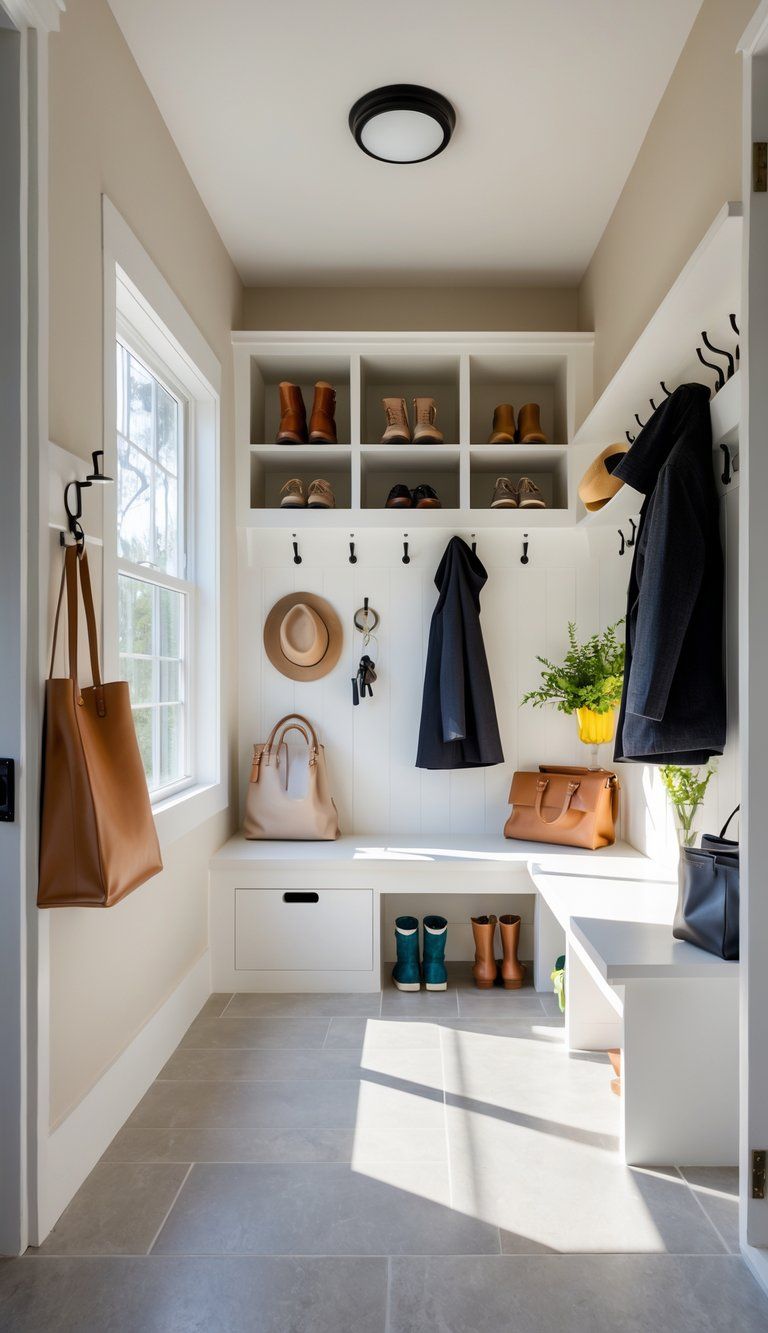
Specialized zones turn any mudroom into a hard-working space. Smart design decisions help you squeeze the most out of every inch and tackle your family’s real-life needs.
Pet and Cleaning Stations
A pet station keeps leashes, treats, and all the other gear organized. Hang hooks for leashes and harnesses within easy reach.
If you’ve got the room, add a built-in pet shower or even just a raised basin with a sprayer. It makes muddy paws less of a headache.
Mount a utility sink if you’ve got plumbing. You’ll use it for dirty shoes, garden tools, or whatever else comes in from outside.
Store pet shampoo, towels, and cleaning supplies on open shelves above. Pull-out drawers work for pet food and toys.
Pet Station Essentials:
- Wall-mounted leash hooks
- Waterproof flooring section
- Storage for pet gear
- Towel rack for quick wipe-downs
Charging Stations and Command Centers
Most of us need a spot for devices these days. Set up a charging station with a couple of outlets and USB ports.
A narrow floating shelf or wall cabinet makes a great command center. Add a bulletin board, a calendar, and mail slots to keep life organized.
If you’re tight on space, a pull-out desk or drop-down surface works for quick tasks like signing forms or sorting mail.
Keep cords tidy with cable organizers. Label chargers so mornings don’t turn into a scavenger hunt.
A little drawer for pens, stamps, and office stuff rounds out this zone without eating up space.
Makeshift and Garage Mudrooms
No mudroom? No big deal. You can carve out a mini-mudroom in a corner, hallway, or even the garage.
For garage mudrooms, just section off a spot near the door. Put up heavy-duty shelves and use weatherproof bins.
Add a bench with cubbies underneath for shoes. In the house, look for underused spots like under stairs or an alcove.
A simple bench with hooks above does the trick for a quick drop zone.
Modular storage lets you change things up as your needs shift. Weather-resistant mats protect floors from wet, muddy boots.
Even a basic setup—just hooks, a bench, and a boot tray—can tame the chaos and keep your home neater.
Incorporating DIY Projects and Personal Touches
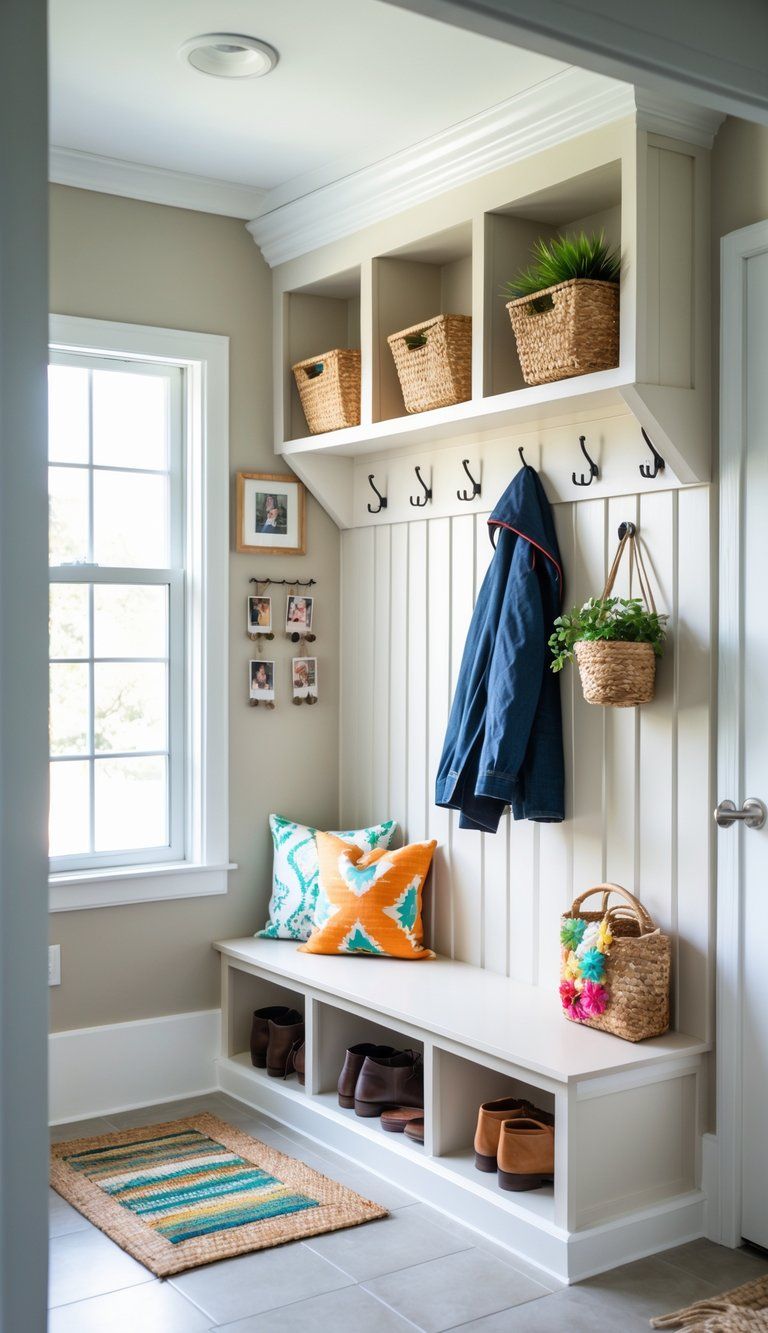
Bring in your own creativity to make your mudroom work for you. DIY projects can solve storage headaches, and personal touches make the space feel like home.
Simple DIY Upgrades
Start small for big results. Install hooks at different heights so everyone can reach.
Paint one wall with chalkboard paint for notes and reminders.
Stack and secure wooden crates to make cubbies—give each family member their own spot for shoes and stuff.
Repurpose vintage containers for storage. Old metal buckets hold umbrellas, and mason jars keep track of keys or sunglasses.
You can DIY a bench with a wooden board and brackets, or just add cushions to a sturdy bookshelf. The space underneath is perfect for extra shoes.
Creative Mudroom Ideas for Small Spaces
When you’re working with a small area, start thinking up instead of out. Try putting floating shelves above your hooks—you’ll get way more storage without giving up precious floor space.
Fold-down tables or desks can make a handy landing spot for mail or packages. When you’re done, just fold them away and reclaim the room.
Stick a magnetic strip right on the wall to hold keys and stash important notes. Even a narrow console table can squeeze in, and if you slide some baskets underneath, you’ll have a spot for all the little things.
Don’t forget the backs of doors. Hanging organizers can hold shoes, accessories, or even cleaning supplies.
Wall-mounted shoe racks keep your footwear in order and use up that vertical space most people ignore.
If you want to get clever, try multi-functional pieces. Storage ottomans give you a place to sit and hide clutter at the same time.
Smart mirrors with hidden storage behind them also make the whole area feel bigger while keeping things organized.

